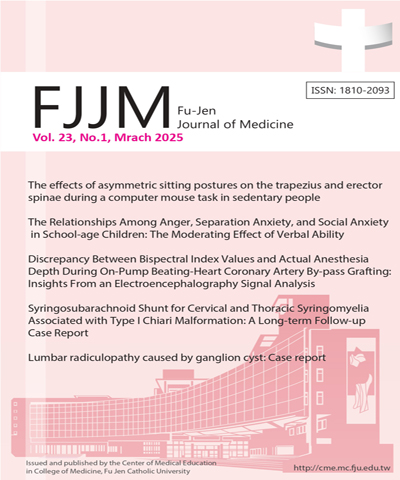
輔仁醫學期刊/Fu-Jen Journal of Medicine
輔仁大學醫學院,正常發行
選擇卷期
- 期刊
Background and Purpose: Patient safety has been a critical healthcare concern in recent years. In this study, we used a structured questionnaire to examine the differences in patient safety attitudes between intensive care unit (ICU) and general ward staff members and explored the future impact of these differences. Methods and Materials: We used the Safety Attitude Questionnaire in this cross-sectional study to assess 6 dimensions of patient safety attitudes of nursing care providers between different units. The scores of the 6 dimensions were compared between different age groups, work experience levels, work units, and managerial functions by using the t test and ANOVA. The multivariable regression model was used to investigate factors that may affect patient safety attitudes. Results: In total, 72 ICU nurses and 164 general ward nurses completed the questionnaire. The scores of the ICU nurses in the 6 dimensions of patient safety attitudes were higher (indicating more positive attitudes) than those of the general ward nurses: stress recognition (74.65 vs. 70.90), teamwork climate (74.17 vs. 71.54), job satisfaction (69.67 vs. 64.63), safety climate (69.18 vs. 68.79), working condition (65.63 vs. 64.58), and management perception (62.36 vs. 60.34). The multivariable regression analysis revealed no significant variations in safety culture between the ICU and general ward nurses, except in the dimension of stress recognition (p = 0.03). Conclusions: Improvements in the dimensions of teamwork climate, job satisfaction, safety climate, working condition, and management perception in ICUs may be warranted.
- 期刊
Purpose: Polymorphism of the uridine diphosphate glucuronosyltransferase 1A1 (UGT1A1) gene is known to be associated with an increased risk of irinotecan-induced toxicities in patients with metastatic colorectal carcinoma. However, limited data are available regarding the UGT1A1*28 genotype in Taiwanese patients with metastatic colorectal cancer. Methods: Between January 2011 and June 2013, metastatic colorectal cancer patients receiving first-line irinotecan-based chemotherapy at Cathay General Hospital and Sijhih Cathay General Hospital who underwent UGT1A1*28 genotyping were enrolled in the present study. Patient characteristics, treatments, adverse events, and outcomes were retrospectively analyzed. Results: In all, 104 patients were analyzed, including 81 (77.9%) with the homozygous wild type TA6/6, 21 (20.2%) with the heterozygous mutant type TA6/7, and 2 (1.9%) with the homozygous mutant type TA7/7. No significant difference in the irinotecan dose intensity was observed among genotypes (p = 0.395). Furthermore, no significant differences in tumor response (p = 0.450) or survival outcomes were observed (progression-free survival, p = 0.713; overall survival, p = 0.854). Neutropenia (p = 0.433) and diarrhea (p = 0.896) had a similar incidence among genotypes. Leukopenia (p = 0.015) was the only side effect that differed among subgroups. Conclusions: UGT1A1*28 genotype TA7/7 is uncommon in Taiwanese patients with metastatic colorectal cancer. A marginal statistical difference in irinotecan-related side effects was observed among genotypes. This finding may have been confounded by physicians adjusting the dosage on the basis of genotype and clinical information. Larger-scale studies are warranted to verify this finding.
- 期刊
Infectious mononucleosis caused by Epstein-Barr virus (EBV) infection is not rare in children. Fever, pharyngotonsilitis and lymphadenopathy are its major presentations. As the EBV mainly targets lymphomononuclear cells and the reticuloendothelial system of the body, some cases may initially be mistakenly diagnosed as leukemic malignancy. Moreover, the location of the swollen lymph nodes may also mislead during diagnosis. We report two children with infectious mononucleosis(IM) who had various initial manifestations that mimicked other diseases. One child presented with a large number of blast cells in a peripheral blood smear, which mimicked leukemia, while the other one had swollen masses within their bilateral subauricular regions, which mimicked mumps. Both children were finally diagnosed as having EBV-related infectious mononucleosis by positive serological testing and recovered after supportive care. A review of the literature regarding atypical presentation of IM is included. It is concluded that physicians should be alert to the various presentations of EBV-related infectious mononucleosis so that they make a correct diagnosis, which will prevent unnecessary examinations and medication of the patient.
- 期刊
Bone cement augmentation of pedicle screw is an important surgical procedure for osteoporotic vertebral collapse, preventing screw loosening, migration or back-out. Bone cement leakage may develop and mostly does not compress the peripheral tissue of the vertebral body including the spinal cord. However, to our best knowledge, bone cement leakage into the inferior vena cava during cement augmentation of pedicle screws for osteoporotic vertebral collapse has been not reported in the literature. We reported an 84-year-old male with asymptomatic cement leakage into inferior vena cava during this procedure and the possible pathophysiological mechanism was also discussed.
- 期刊
Gas-forming pyogenic liver abscess (GPLA), an uncommon and potentially fatal disease, represents 7%-24% of pyogenic liver abscess cases. Diabetes mellitus is a well-known risk factor for pyogenic liver abscess. Here, we present a case of GPLA in a 65-year-old man with diabetic mellitus and hypertension. The patient received computed tomography-guided percutaneous drainage, third generation cephalosporin and insulin control for hyperglycemia. He was discharged 20 days after admission without any complication.
- 期刊
Introduction: Uterine perforation with an intra-abdominal intrauterine device (IUD) resulting in consultation to a general surgeon is rare. However, migrated IUD due to uterine perforation, regardless of the severity of symptoms, should be promptly removed surgically to avoid further bowel perforation or obstruction. We report a case of intra-abdominal IUD utilizing laparoscopic removal. Case: A 28-year-old woman who suffered from vaginal spotting for six months following levonorgestrel IUD (MirenaⓇ, Bayer, Leverkusen, Germany) implantation. An initial diagnostic workup, including the performance of a transvaginal ultrasound, pelvis X-ray, and pelvic computed tomography (CT) scan, was completed to localize the IUD. Then, laparoscopy was performed to remove the device smoothly. Conclusions: Intra-abdominally-located IUDs due to uterine perforation are usually diagnosed by gynecologists, but further consultation to general surgeons can be encountered sometimes. Imaging studies such as pelvic X-ray or abdominal CT are recommended to assess adjacent organ involvement or perforation. Laparoscopic extraction are feasible and beneficial in most cases.

